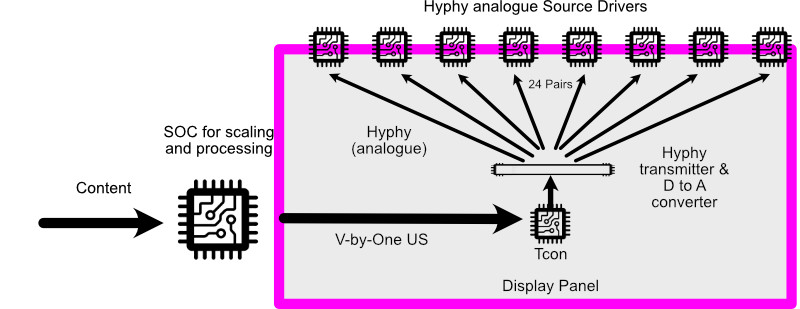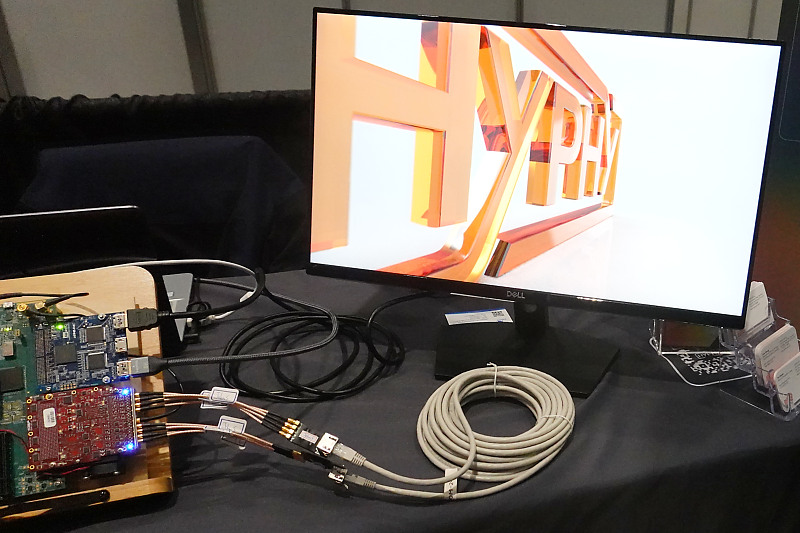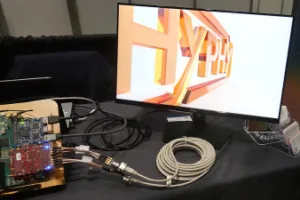A favourite area of the Display Week show is the iZone which provides a way for small start-ups or not yet commercial research projects to show what they are doing with a low level of financial commitment. I stopped by to talk to Hyphy which has a new approach to internal display interfaces.
Internal interfaces are a key part of the design of display systems. However, as you get to bigger panels, and especially with 8K there is a huge amount of data to transmit across longer distances. That’s technically and economically challenging and the cost of drivers is a significant part of the increased cost for 8K displays.
Hyphy has what it believes is a solution to this. The company has a new technology for high speed analogue signal transmission that has real advantages in this application. Normally, the data from a TCon, which controls the sending of the data from the SOC or scaler that is controlling the incoming signal is sent to the source (column) drivers along the edge of the panel. The challenge is that with 23,040 columns in an 8K display, it’s challenging to send the digital data fast enough. It also uses a lot of LVDS channels (48) and cables (96).
 The conventional signal path for 8K displays. Image:Meko
The conventional signal path for 8K displays. Image:Meko
 Hyphy’s alternative approach Image:Meko
Hyphy’s alternative approach Image:Meko
Hyphy is based in Australia and takes a different approach. Rather than sending digital signals which are then converted to analogue to actually drive the display in the source drivers, the firm sends the data as modulated analogue signals from the Tcon. The firm clarified its approach as
“We take the incoming video signal, accumulate a set of video data into a large buffer, then use codes to encode multiple buffer-sets into a modulated analog signal which has a high video information throughout and robust EM characteristics”.
It means that you have to use Hyphy’s own driver chips, but has two key advantages. First, the firm says that it can use just 24 signal pairs and because the data is sent at a much lower frequency than using digital data, it can use longer cables. The firm takes advantage of the concept of spread spectrum transmission that is behind a lot of the recent advances in mobile telecommunications. It claims to be able to achieve 10X faster transport of data.
The transmission technique is not lossless. There is some degradation of the signal, but, the firm says, it is ‘visually lossless’, in other words, the small errors in the transmission are not big enough to be visible. Further, in TV applications, where content will already have been through a codec process, any distortions from the interface are going to be smaller than what is added by the compression process. Because the system is designed to be used inside the set, the length of cable is known, so some compensation can be applied to optimise the signal.
At Display Week, the firm was taking an HDMI signal, sending it through a coil of UTP network cable, then back to the display with no obvious degradation or visible noise.
 This is how the technology was demonstrated at Display Week
This is how the technology was demonstrated at Display Week
The firm says that it has tested distances up to 300M in its labs. On that basis getting from one spot on the back of a 100″ class display panel becomes relatively easy. It also means that the Tcon can be placed wherever the display maker wants on the back of the panel, rather than being limited by the wiring.
 The signal on the display was passed through the coil of UTP cable. Photo:Meko
The signal on the display was passed through the coil of UTP cable. Photo:Meko
At this stage, as Tcons are currently designed to output digital signals, the firm would have to put its D/A converters near the Tcon. Of course, in the longer term, it would be logical to put the converters in the Tcon itself. If you have the imagination, you can see that the technique could also be used between the scaler and the Tcon and could even be feasibly used beyond that. Current digital interfaces are currently challenged to meet the speed requirements for high refresh 8K with HDR and WCG. Making that easier might be interesting! However, that kind of development would be a long way away.
Hyphy’s business model at the moment is to act as a fabless chip company, but in the longer term it is more interested in licensing the technology and transitioning to an IP licensing model. However, the market has to be developed before that can happen. Given the challenges in the supply chain at the moment, I asked about the kind of process node needed for the chips, and the firm confirmed that it uses a low level process node. The current chips were made on 180nm, but production volume would be better at 55nm – 130nm.
Analyst Comment
It can be very hard to get established display companies to change how they make their displays, but this technology doesn’t affect the LCD cell itself, except for the attachment of the drivers. For companies trying to enter the supply chain, a key requirement is to solve a pain point. There are both cost and technology challenges for panel makers so Hyphy has two ways to ease the pain of the makers. (BR)
Note that the firm contacted us after publication to clarify how it works and modified the optimum range of processes for the chips that it had recently given us. It also said that it prefers to be called ‘HYPHY’, but Display Daily does not like to use all caps for company names.

